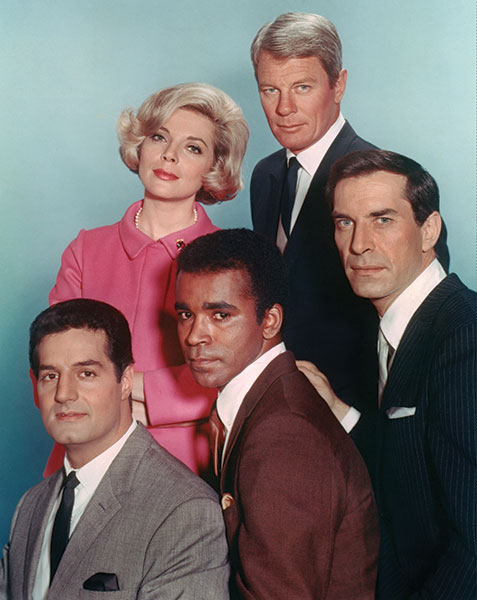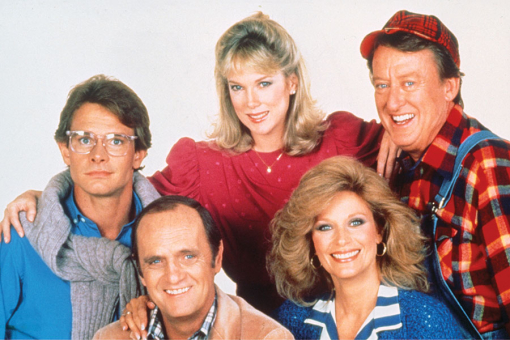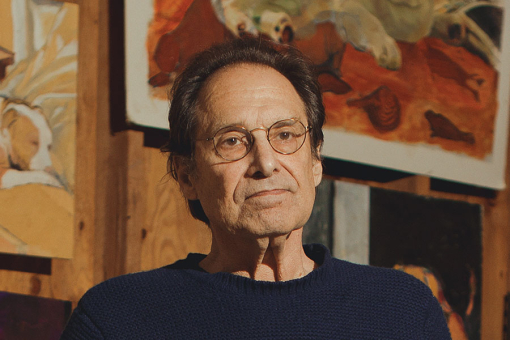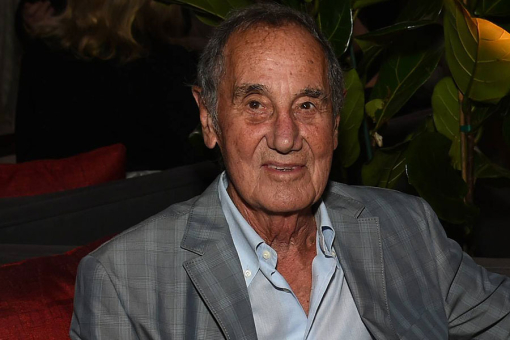When it debuted 50 years ago, Mission: Impossible had audiences hooked from the opening thrum of those bongos.
Besides the music by Lalo Schifrin, there were the race-against-time plots, gee-whiz gadgetry and elaborate disguises.
Sandwiched between the sitcom Pistols 'n' Petticoats and the western Gunsmoke, the drama about an elite team of covert U.S. spies was CBS's answer to Hollywood's popular James Bond movies.
The series, which ran for seven seasons, won 10 Emmys (including two as outstanding drama series, in 1967 and '68) and received 26 Emmy nominations. After syndication success, the show spawned a reboot series on ABC (1988-90), five blockbuster features starring Tom Cruise — a sixth is in the works — and at least half-a-dozen video games.
From the start, in September 1966, the series ingeniously exploited television as a visual medium — viewers needed to watch attentively to follow the complex plots.
And the premise was titillating: against a Cold War backdrop, five secret agents engaged in risky subterfuge to thwart implied Iron Curtain and Third World dictators plotting against the U.S. In the show's later seasons, the villains were American mobsters.
But the outcome never changed: no matter how dangerous and challenging the mission, the Impossible Mission Force prevailed.
A huge domestic and international hit, Mission: Impossible nonetheless had its share of critics. Reviewing the premiere, Jack Gould of the New York Times called it "...noteworthy for its unusually imaginative and varied photography and for a series of technical gimmicks that succeeded in diverting attention from Bruce Geller's script, which was more of a cue sheet than a repository for dialogue...."
Still, creator-executive producer Geller would pick up two Emmys for his efforts, both in 1967 (for writing and for outstanding drama series). Prior to Mission: Impossible, he had written for shows such as Have Gun — Will Travel and The Rifleman. But his sights were sharply set on feature films.
Inspired by the caper Topkapi (1964) and the French heist flick, Rififi (1955), Geller envisioned Mission: Impossible as a feature. On his agent's recommendation, he shaped a script — first titled Briggs' Sguad — as the pilot of a TV series and took it to Desilu Studios, which was seeking a new hit.
Herbert F. Solow, Desilu's vice-president of production, sold the pilot to CBS, which ordered 28 episodes of the expensive one-hour series. At the same time, Solow sold Star Trek to NBC. The two shows were the first he put into development after joining Desilu.
Once on the air, Mission: Impossible would be known for major cast changes. After the first season, Steven Hill, who played team leader Dan Briggs, was replaced by Peter Graves as Jim Phelps. (Graves died in 2010.)
Costars Martin Landau (Rollin Hand, a master of disguise) and his then-wife Barbara Bain (as femme fatale Cinnamon Carter, she would win three Emmys) opted to exit after the third season.
Landau was replaced by Leonard Nimoy; his character, a magician, was known as the Great Paris. He would later grumble that in replacing Landau, he felt like "an implant." (Nimoy died in 2015.) A series of actresses stepped in as the seductress, including Lee Meriwether, Lesley Ann Warren, Lynda Day George and Barbara Anderson.
The only leads appearing in the entire run were Greg Morris (who died in 1996), as techno¬whiz Barney Collier, and bodybuilder Peter Lupus, playing strongman Willy Armitage. In the fifth season, Sam Elliott was brought in as Dr. Doug Robert, when producers decided to ditch Lupus's character. But Lupus fans campaigned successfully on his behalf.
The show's opening titles — accompanied by Schifrin's iconic theme — are memorable: two hands in closeup strike a match that ignites a fuse, which, over a tension-filled action montage, burns relentlessly.
The standard opening scene depicted the IMF leader receiving secret audio tape-recorded instructions about the team's upcoming mission. Voiced by Robert Cleveland Johnson, an accountant and voiceover actor, the message went mostly like this:
"Good morning, Mr. Phelps (or Briggs)." A description of some dire situation would follow. Then: "Your mission, Jim (or Dan), should you decide to accept it, is to..." Then the no-nonsense voice would go on to explain the perilous assignment.
"As always," the unidentified voice concluded, "should you or any of your IM Force be caught or killed, the Secretary [of Defense] will disavow any knowledge of your actions. Good luck, Jim (or Dan). This tape will self-destruct in five seconds."
Then the recorder would disintegrate — via special effects — in puffs of smoke.
The show's greatest challenge was to keep Geller on budget — a mission that was nearly impossible. Still, by the third season, the show reached number 10 in the ratings, tying with The Beverly Hillbillies.
In 1967, Gulf + Western acquired Desilu, turning the studio into Paramount Television. Geller's continuing budget-busting so infuriated the show's new producer that the Mission:Impossible creator was eventually barred from the set, accordingto Patrick J. White, author of The Complete Mission: Impossible Dossier.
Five years after the show's cancellation, in 1978, Geller was killed when his private plane crashed into a mountain near Santa Barbara, California. He was 47.
Ironically, perhaps the most lasting impression of this visually oriented series is aural: Schifrin's multi-Emmy-nominated, Grammy-winning theme, which hit Billboard's Hot 100 list as a single in 1967.
To celebrate the series' 50th anniversary, emmy contributor Jane Wollman Rusoff interviewed many of the principals who worked on this groundbreaking show. Here are their memories, in alphabetical order:
Elizabeth Ashley
Lois Stoner in the episode titles “Encounter,” 1971; Andrea in “The Question,”1973
"I was a Broadway stage actress who retired and became a Beverly Hills housewife — that's like being held hostage at Folsom, but with better upholstery.
"So when I divorced and went back to work, I'd lost all my confidence as an actress; I didn't know if I had the chops to do it again. Mission: Impossible was the gig that restored my confidence.
"Some scenes required huge emotional outpourings. So I had to call up my Actors Studio and Sanford Meisner training. They asked me back to do another episode, with Gary Lockwood. It was quite fun, but not a part that required a huge amount of acting: there were a lot of car chases and guns and running and driving."
Barbara Bain
Cinnamon Carter,1966-69
"Bruce Geller knew my work from an acting class we were in together. He wrote the role of 'The Girl' [Cinnamon] for me, but didn't tell me. I had to go through the audition process because I was an unknown actress, which was a curse in Hollywood at the time.
"Bruce wanted The Girl to be someone who could be up there with the boys, doing the work and still be sexy. That was very hard to cast back then — you were either the pretty dumb blonde or the smart housewife.
"Ultimately, Lucille Ball had to approve me. I went into her little bungalow. She looked me up and down: 'Well, looks all right to me,' she said.
"The network and studio were initially alarmed about [African-American] Greg [Morris] and me [a Caucasian] standing next to each other in a scene. That sort of thing just wasn't done at the time. I mean, Nat King Cole's show wasn't even carried in the South.
"So CBS and Desilu were terribly frightened. Of course, Bruce would [deliberately] place Greg and me next to each other. Everyone was sure that all of America would fall apart. Instead, all of America embraced the show.
"Bruce made his decisions and then fought the world by being incredibly quiet. When the [studio and network] would tell him to cut days or whatever, he'd just go, 'Ho-hum' — and then do what he wanted. He never engaged with them.
"In one episode ['The Heir Apparent'] I was playing a blind woman and had to wear a nun's habit. I visited a [school for the blind], so I could watch the behavior. As I walked through the cafeteria, the sighted help thought I was a nun. I giggled to myself.
"[In 'Illusion'] I played a Marlene Dietrich [type], and Standards & Practices had to okay what I was wearing — they were a little concerned about the garters. So they escorted me somewhere and I had to stand there, in costume, while a gentleman looked me over.
"Peter Graves was a very honorable, responsible, lovely man. We were all very young, but he was a man, not a kid. One time during the set-up of a scene, he was lying in bed and fell asleep. It was very funny — and we never let him forget it!"
Brooke Bundy
Katherine in “The Controllers,” 1969
"We were running away from the bad guys in some country like Ukraine. I had to create an accent. It was a little German, a little French, a little Swedish. I was playing a girl around 17; I was actually 25, but everyone thought I was much younger.
"The adult actors didn't fraternize with us kids; they just did their thing. The set was very professional and serious. You came in, got your lines down and were ready to rehearse."
Joe D’agosta
Casting Director, 1966-69
"In Bruce Geller's mind, Mission: Impossible was to be a one-shot deal, even though he was writing the pilot for a series. After it sold, he said to me: 'What do I do now?'
"Bruce's advice — when I told him that I couldn't write — was, 'Anybody can write. The difference between writers and non-writers is that writers write it down.'
"Bruce was probably the best man I ever met, not a false or selfish bone in his body. After his death, Bernie Kowalski [M:l director and Geller's production partner] and I had to go to the airport to pick up his little sports car. It was sitting outside the hangar, like a loyal puppy waiting for its master to come home. Very sad.
"The atmosphere at Desilu was a complete family affair. There was no sense of a chain-of-command. [Desilu vice-president] Herb Solow was very hands-on and visible. He was a bright young man in TV, mainly because he sold two very original television shows [Mission: Impossible and Star Trek] in one fell swoop."
Martin Landau
Rollin Hand,1966-69
"Bruce Geller wrote the character for me. I was only going to do the pilot. Barbara Bain, who was my wife at the time, was set for the series.
But when [CBS president] Bill Paley saw the pilot [in which Landau appeared], he said, 'I'm not going to put this on unless [Landau] is a regular.' So I made a deal with a two-week cancellation clause so that I could get out at anytime and do a feature. It was unheard of at the time.
"I only did three seasons, but I was in 80 episodes. My character was originally called Martin Land, but I said, 'That's got to go.' So I became Rollin Hand.
"Bruce wanted a girl [for Cinnamon] who could play Marilyn Monroe and Grace Kelly, and Barbara could do that. She could play cheap and she could play sophisticated. Lucille Ball had to approve her. Lucy liked her a lot because she reminded her of the girls she'd competed with in Hollywood.
"With all the masks that I wore on the show, I was like a one-man rep company. I was someone else in every episode and used dialects of all kinds. In the pilot, I played Rollin Hand but also a South American dictator — a big, bloated fellow with no hair. We kidnapped him, and then I impersonated him.
"I left after three years, when Desilu was sold. I didn't like some of the people that were brought in to run it and they didn't like me. The guy who took over the show wanted to make a name for himself; he was nasty to Barbara and me. I was vociferous. We left because of contractual problems, but they lied about why I left.
They said I insisted on more money than Peter Graves was making, and I didn't."
Peter Lupus
Willy Armitage 1966-73
"In the pilot, I had to carry Wally Cox around in a suitcase, which weighed around 60 pounds empty. Wally weighed about 175. For balance, they put the same amount of weight in another case I carried with my other hand.
"So I was carrying about 235 pounds — and we had to do a few takes! When I got home, I was sure that my arms were a quarter-inch longer.
"On the first day, when they yelled 'Lunch!' I set the suitcases down and started to take off.
"Then I heard this knocking: 'Help! Help!' Wally was locked in the case. I had totally forgotten about him.
"They had trouble casting my role because a lot of guys showed up who were not real muscular. When I came in, Bruce [Geller] and Lucy [Ball] were there. I had a sport coat and a skin-tight knit shirt on. I asked, 'Do you want me to take off my coat?' They said, 'Oh, yes. Please.'
"In one episode, I had to sneak Barbara Bain into a Middle Eastern jail. She was in a food cart with a lid. [In real life] she had terrible claustrophobia, but she was determined to do that scene. When we got to the [destination], I lifted the top off right away and saw that she had tears in her eyes. She was really a fighter.
"Once, I had to get Lee Meriwether out of a prison and bring her down on a rope from a roof about 50 feet high. We could feel the rope stretching. Finally, it broke. I fell and Lee fell right on top of me, hitting me on the head. They took us both to the hospital. The doctor said she would have broken my neck if I hadn't been working out.
"In another show, I had to sneak into a dark basement and squirt a can with some substance to disable the alarm system. So I crept in and squirted it, but [someone] had turned the can around, and I got shaving cream all over my face!
"I was supposed to be the strong, silent secret agent. I didn't have much dialogue, but I had one of the biggest fan clubs on the show. I'd get letters saying, 'We counted all your words last week, and we just loved it!'
"The show felt they could draw a younger audience with Lesley Ann Warren, and they had her wearing undergarments so you could watch her body move. But that didn't go over with women. In the office, they showed me bags of letters from women who were negative about Lesley. Peter Graves was upset, too: 'Why would you bring her on against my [older] character? I look like a dirty old man!'
"During the Watts Riots, they were shooting and throwing rocks at cars in downtown L.A., near where we were filming. They sent extra police to be on our set because they were afraid the riots would come our way. They didn't, but they were within a mile. Greg Morris said to me, 'Stick with me. I'll save you!"'
Don Marshall
Police Officer in “The Ransom,1” 1966
"I was asked to do a third episode of the series Daktari, and I didn't want to because I was playing second fiddle to a chimpanzee, a cross¬eyed lion and Marshall Thompson [as veterinarian Marsh Tracy], So I didn't do it, and my agent blacklisted me.
"I called my friend Gene Roddenberry [creator of Star Trek], He said, 'Do a Mission: Impossible; as soon as your name hits the trades, the blacklist will be lifted. I did it. It wasn't a big part, but I did it because Gene said to. I got my name in the trades — and the blacklisting was over."
Lee Meriwether
Tracey, 1969-70
"Bruce Geller asked me to become a member of the Impossible Missions Force after he saw me in a show in which I was stuck in an iron lung.
"It was a miracle that I gave anything close to a good performance!
"In the first episode that I did, I played someone [a European] that Barbara [Bain] pretended to be. She told me to not use any contractions when I spoke, like can't or don't. She was right, because if you speak English [with a foreign accent] and use contractions, you don't sound authentic.
"Peter Graves was such a gentle soul, very caring. He carried a lot of the show.
"Peter Lupus saved my life when I fell on him when the rope we were on broke. After that experience, I kept dreaming about falling. I had to do a scene in another episode, on top of a building. I looked down and said, I just can't.' So they built a rooftop set on the soundstage. As I came to the edge and started to look down, the [rope accident] all came back.
"Greg [Morris] said, 'You know, it's not really that far down. All you have to do is hold onto this bar. Look.' As he grabbed the bar, it pulled away from the wall and he almost fell. He said, 'She's not filming this!'
"I loved being on the show. I was hoping I'd be on longer, but they wanted somebody younger to be a regular, and that was Lesley Ann Warren."
Adam Nimoy
Son of Leonard Nimoy, The Great Paris, 1969-71
"After Star Trek, my father replaced Martin Landau as the master of disguises. There were very demanding costume and makeup changes, and a lot of dialects to learn. It was very emotionally exhausting for him. And his character had no real inner life. He was just a cardboard character who was always playing other people. There was nothing fulfilling for him in terms of his character's internal life."
Eddie Paskey
Steve in “The Carriers“ and “The Ransom,” both 1966, and a man removing a suitcase in the pilot
"We were shooting the pilot on Christmas Eve at Mount St. Mary's University [in Los Angeles], My God, it was cold. We were supposedly in a tropical setting: I was wearing a thin white summer suit.
"Everybody was freezing. But we had to get the shot so we could sell the pilot. I had taken along a flask of brandy, and we went through a pint that night. It got us warmed up. [My wife] Judy and our two kids had dinner with me on the set because I couldn't go home."
Marion Ross
Mrs. Foster, “A Ghost Story,1”1971
"I played the housekeeper but I was the villain. I dressed in a man's suit and had a gun. I was so taken with myself in that outfit! I thought I looked like Marlene Dietrich. But when I watched the show, I saw that I looked like Charlie Chaplin. Honest to God, I wanted to die!
"My character had to shoot through a doorway, and then my arm was slammed by the door to make the gun fall out of my hand. They offered to use a stunt person, but I said I could do it. Well, such a hit on my elbow! It was unusual because I'm not normally the villain."
Lalo Schifrin
Composer of M:l theme and episode scores
"Bruce Geller said to me, 'I want you to write something exciting and different, something that will get people's attention. Like, when they're in the kitchen having a soft drink and the television set is in the living room, they'll hear it and say, "Oh, Mission: Impossible is on!"' Then they'll run immediately to the living room.
"In jazz or rock-and-roll, the rhythms are usually four beats to a bar, sometimes two. But ‘Mission: Impossible' is neither — it's in 5/4, which is very unusual. Bruce sent me the script, but I didn't understand what he had in mind. So I went to a shooting session, and I still didn't understand it. But once they edited it and had the final version, I understood it.
"I didn't compose "'Mission: Impossible' at a piano. I write at a desk. I had a very short time to write it, as [television] music is [usually] composed in the postproduction phase. So I had to do it right away. I sat at my desk and wrote that theme in exactly one-and-a-half minutes.
"It was not inspiration; it was a need to do it. It was a little mission—impossible! The whole thing — including the chorus, the bongos, everything you hear — took me maybe three minutes."
Alexander Singer
Director, “The Seal,”1967, and four other episodes
"In a private vault [in a penthouse] was a stolen [jade figure] worth millions. The only way to retrieve it was to send in a cat to walk on a metal tightrope across the room, pick it up and carry it out. We used four trained cats that looked alike. After about 10 or 15 minutes, each cat would get bored. That's why we had four.
"Each cat specialized in something: one was good at opening a container, one was good at opening a door. It was hard to keep a straight face. It took three days to shoot that scene. Everybody was exhausted, but it worked out beautifully.
"Bruce Geller didn't come on the set often. He was a demanding producer and very stingy about complimenting your work. But when he did, you believed him. He kept an edge on it so you'd keep trying."
Herbert F. Solow
Vice-President of production, Desilu Studios,1964-67
"The biggest challenge in producing the show was the cost. The [scripts] were set in a variety of places in the world. Fairfax High School in L.A. became a Hungarian prison.
"I left Desilu soon after Gulf + Western bought the studio. When I resigned [and became vice-president of television production at MGM], some people on Mission got very upset, mainly Marty Landau. He and Barbara Bain left, too. Then they were looking for someone to replace Marty.
"When Star Trek was canceled, I got a call from Leonard Nimoy. He told me that he'd been offered the job to replace Marty. He asked what I thought. I said, 'I think it would be the worst decision you ever made in your life — one, because of the show's budget problems, and two, you're not the kind of actor to replace someone.'
"Bottom line: He took the job because they offered him a lot of money. Years later he said, 'I should have listened to you. It was the worst time I've ever had acting.'"
Loretta Swit
Midge Larson in “Homecoming,” 1970
"I loved it because I was the murdering villain, though an unlikely suspect. But by the end of the show, the Mission: Impossible team got me. Basically, my character was a good lady who flipped her cork for a moment. She felt she'd been thrown aside and neglected, and was on the pity pot, feeling sorry for herself.
"I was seen stalking, but you didn't see me committing the murders. I was [in disguise]. My hair was in a cap and I wore dark glasses. I remember the denouement, when they caught me crumpled up on the ground and crying desperately."
Lesley Ann Warren
Dana Lambert,1970-71
"My character wasn't there to participate with the team's mechanics. I just had to bring my acting. In one episode, I was a singer with a band and had to pretend I was overdosing. It was very emotional.
"When Barbara [Bain] and Marty [Landau] left, the studio and network decided to take a whole different approach to the characters. The fact that I was so young was incorporated into some of the storylines — my innocence was written into the character. And because I was so young, it was intimidating. Some people started looking at me as too young.
"Peter Graves was hysterically funny, which people don't know about him, because he played such a serious character on the show. But he was a very witty man.
"Leonard Nimoy was the other person that I bonded with most. We became very close because we were the newbies. Most of my scenes were with him. He was a really serious actor, dedicated to the craft, as I was. I went on to do Night Gallery with him, which was the first project he directed.
"In the end, Mission: Impossible wasn't my cup of tea because it was dedicated to the complexity of the plots and the intricate mechanics of that world, and I was more interested in character development. So I chose to move on after that first season."
This article originally appeared in emmy magazine, Issue No. 7, 2016











